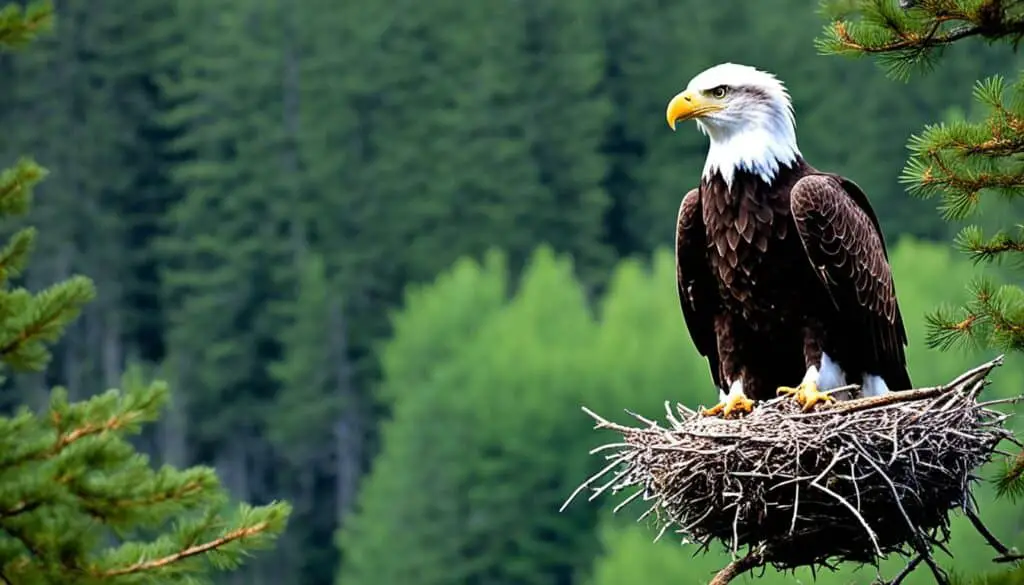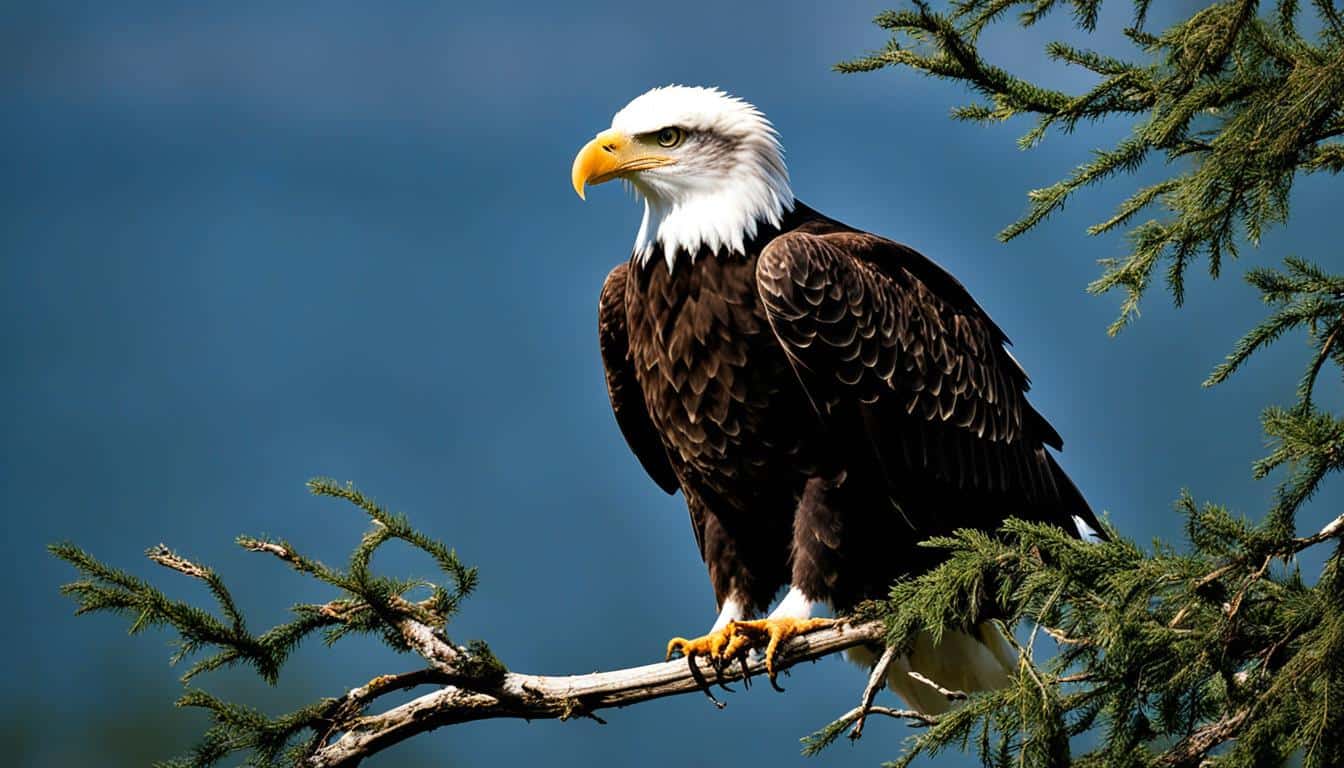Have you ever wanted to know why bald eagles’ nests are so special? Their nests are not just homes; they’re key to their survival. Bald eagles are very particular about where and how they build their nests. They often choose places close to water where food is abundant. During the spring and summer in places like Alaska, these eagles show incredible loyalty. They build huge nests out of sticks and soft materials. Both male and female eagles work hard on their nests, which can weigh a lot. This shows just how important their nests are to them.
The process of breeding and nesting is a delicate one for bald eagles. It includes special rituals, laying eggs, keeping them warm, raising the chicks, and then teaching them to fly. But, humans can easily disturb this cycle. This is why there are rules in place to protect these birds and their nests. These rules help us enjoy these magnificent creatures without causing them harm.
Bald Eagle Nesting Season
The bald eagle’s nesting time is very important for their babies to grow. They follow a clear cycle, but this cycle changes in different places. Knowing about these changes helps to keep these big birds safe.
Timings and Variations
The time when bald eagles nest changes a lot based on where they live and the weather. In Alaska, it starts in February and goes until September. During this time, they do things like find a mate, build a nest, lay eggs, and raise their young.
This whole process can take about six months. It’s crucial for the baby eagles’ growth and safety. Every step, from finding a partner to taking care of their chicks, is important.
Regional Differences
In places like Alaska, eagles start nesting much earlier than in the south. They time everything with the weather to make sure their babies have the best chance to survive. So, weather and food are key factors that make each area’s nesting different.
Impacts of Climate
The weather really affects the bald eagles during nesting season. If the climate is steady, more food is available, and nests are safer from harm. But, if the weather is wild, their nesting time might not go well. This could mean fewer baby eagles surviving.
It’s very important to protect the places where eagles nest, especially when the weather is changing a lot. Humans should avoid disturbing these areas, especially when the eagles are actively nesting.
Bald Eagle Habitat Preferences
Bald eagles choose their homes carefully. They need the right environment to live and have babies. It’s important to know what they need to protect them.
Preferred Locations
Bald eagles love spots near big water. These areas include forests next to rivers, coasts, and lakes. This environment offers plenty of fish and other food, which is key for their survival.
Proximity to Water
Being close to water is a must for bald eagles. In cold weather, they need open spots to find food easily. They nest in tall trees close to water, which gives them protection and a good view.
Climatic Factors
The weather greatly affects where bald eagles can live. They pick places where they can fish all year, even in winter. Choosing tall, sturdy trees helps protect their young in all kinds of weather.
What are the nesting habits of bald eagles?
Bald eagles are flexible with where they build nests. They prefer places with lots of food and few people. This allows them to keep their babies safe and well-fed.
Their nests are usually high up in big trees or on hidden cliffs. These spots are carefully chosen. They offer both safety and a good way to find food. It shows how smart and resourceful they are about their bald eagle nest location.
The eagles’ work on their nests is serious. They build them big and strong. This shows they are dedicated parents. Their goal is to make the best home for their young ones to do well.
Here is a detailed observation of bald eagle nests and their strategic locations:
| Feature | Description |
|---|---|
| Height | Nests are often placed high in trees to avoid ground predators. |
| Proximity to Water | Nests are usually located near water bodies to facilitate easy access to food. |
| Construction | Crafted from sticks and lined with softer materials for comfort and insulation. |
| Location Types | Built on towering trees or secluded cliffs for optimal visibility and protection. |
Learning about these habits helps us see how amazing bald eagles are. They use smart strategies to protect and help their young grow.
Bald Eagle Nest Building
Bald eagle nest building is truly amazing. These giant birds work hard to make nests that are safe for their babies. They choose every material carefully.
Materials Used
Bald eagles are smart about what they use to build nests. They start with big sticks to create a strong base. Then, they add soft things like grass and feathers inside. This makes a comfortable space for their eggs and babies.
Both the mom and dad eagle help collect these materials. This shows they are great team players.
Nest Dimensions
The size of an eagle’s nest will surprise you. They can be 5 to 6 feet wide and about 2 to 4 feet tall. These nests may get larger as years go by. More materials are added each season. Some nests can end up weighing a ton!
Construction Process
Building a bald eagle nest takes time. It can take many months to finish. Both parents work hard together, using sticks to make a strong nest. They then fill it with soft things to keep their eggs warm. They never stop improving their nest.
Nesting Sites and Tree Selection
Bald eagles pick their nesting spots carefully, choosing specific types of trees. This decision isn’t just by chance. It’s all about making sure their babies are safe and thrive.
Forest Types
Bald eagles like to nest in mature forests with old and young trees. They find these forests near water, which is full of fish that they eat. It gives them the perfect place for both finding food and making a home.
Preferred Tree Species
For nests, bald eagles like some trees more than others. Common ones they choose are:
- White Pine
- Sycamore
- Tulip Poplar
They choose these trees for their size and strong branches. A big, secure nest is a must for raising their chicks safely each year.
Elevation and Visibility
Where the tree is and how high it is really matters to bald eagles. They like high trees because it helps them see far. Being up high also makes it easier to fly in and out of the nest, which is important for these large birds.
| Tree Species | Main Benefits |
|---|---|
| White Pine | Height, Visibility, Strength |
| Sycamore | Wide Base, Sturdy Structure |
| Tulip Poplar | Tall Height, Abundance |
In the end, where and how bald eagles build their nests shows their smart choices. They look for the best forests and trees, and they aim high for a great view and flying space. This is key to their success and keeping their kind alive in the wild.
Bald Eagle Nest Maintenance
Taking care of a bald eagle nest is a year-round job that needs regular attention. Every year, the eagles come back to their nest to make sure it’s safe and strong. They do this to protect their homes and make sure they last a long time.
Annual Repairs
The eagles go back to the same nest all the time. This means they have to fix it up each year. They fix any damage from the weather or last year’s use. This keeps the nest strong, even as it gets bigger with more materials.
Additions Over Time
In addition to repairs, the eagles also add new things to their nest. These additions make the nests really big, sometimes weighing a lot. These changes show how careful and dedicated the eagles are to their nests. They work hard to make sure it’s a good place for their babies.
Bald Eagle Nesting Cycle
The bald eagle nesting cycle is important for their survival and growth. It starts with building a nest. Both parents work hard to make sure the nest is sturdy and safe.
This season begins with courtship which leads to building the nest. Eagles do this for months. They gather materials to make the nest safe for laying eggs.
After the eggs are laid, comes the incubation stage. Both parents keep the eggs warm. They do this to protect the eggs from dangers. This step is really important for the baby eagles to grow well.
When the eggs hatch, the nestling stage starts. The baby eagles, or eaglets, need a lot of care and food. The parents work hard, making sure the eaglets are safe and learn important skills. They must be strong before they can leave the nest.
Then, it’s time for fledging. In this stage, the young eagles practice flying. They start becoming independent. This is a key step for the young eagles to do well in the wild.
Knowing all about the bald eagle nesting cycle shows us how much care they put into their young. It teaches us about the habitat they need. This helps the eagles grow up healthy and ready for life on their own.
Breeding Behavior and Courtship
The bald eagle breeding behavior is fascinatingly intricate. It showcases dramatic and highly visual spectacles. These birds engage in various bald eagle courtship rituals. These actions help them strengthen their bond and prepare for egg-laying and nesting.
Courtship Displays
Bald eagles have amazing courtship displays, mainly in the air. They show synchronized acrobatics and talon-locking freefalls. In the freefall, eagles lock claws and spiral down in a breathtaking dance. These displays show they’re ready to mate and fully commit to their nest.
Pair Bonding
Pair bonding is critical for the bald eagles’ breeding success. They do this through repeated calls and complex flight patterns. These activities occur in late winter. They strengthen their partnership and mark their territory. This process helps ensure a successful breeding season.
Egg Laying and Incubation
The bald eagle’s egg-laying and incubation time is very important. Female eagles usually lay one to three eggs. Both parents care a lot for their eggs to make sure they will hatch and grow.
Protecting the eggs and keeping them in the right conditions is their top priority.

Clutch Size
Generally, a bald eagle couple will have one to three eggs. Yet, sometimes there are more or fewer. This depends on how much food there is and the condition of the environment.
They lay the eggs over a few days. This makes sure the baby eagles, called eaglets, hatch at different times. It helps the parents care for each eaglet better.
Incubation Period
Eagle eggs need about 34 to 36 days to hatch. Both mom and dad take turns in keeping the eggs warm. The female eagle usually spends more time doing this.
Keeping the eggs at just the right temperature is critical for the babies’ health.
Parental Roles
Parent eagles have specific jobs during laying and sitting on the eggs. The mom often covers the eggs. The dad looks for food and protects the nest.
Teamwork is essential for the eggs to hatch successfully and the baby eagles to survive.
Raising Eaglets
Raising bald eaglets takes a lot of work. Their parents put in a big effort. This is to make sure the young eagles grow up strong and able to live on their own. From when they hatch until they leave the nest, the parents feed them and help them through key life phases.
Feeding Practices
Adult eagles share feeding their young. At first, the parents hunt and bring food to the nest. They tear the food into small pieces for the eaglets. As the babies grow, they need more food. The parents feed them often and with bigger pieces of food. This shows how caring for a young bald eagle is a full-time job.
Development Stages
Bald eaglets go through many stages to get ready to leave the nest. At first, they rely on their parents for everything. As they grow, they get stronger and learn to move better. This is all practice for trying to fly and hunt. Watching them grow tells us about the amazing journey of a bald eagle’s youth.
Fledging Process
Leaving the nest is a big deal called fledging. Eaglets start with short flights close to home. These early flights help them get strong and learn to fly well. Soon, they’re ready to hunt for themselves and explore their world alone. This phase shows how much work and care the parents put into raising their future eagle adults.
FAQ
What are the nesting habits of bald eagles?
Bald eagles have very specific nesting habits aimed at their survival. They choose to nest in tall trees close to water. They use large sticks to build their nests, softening them with other materials. Both male and female eagles work together, creating huge nests they maintain each year.
What is the nesting season for bald eagles?
The nesting season for bald eagles changes based on where they are. In Alaska, it runs from February to September. This time covers all the activities from starting a nest to helping eaglets learn to fly.
How do bald eagles choose their nesting sites?
Eagles look for spots in forests near water. These places are in trees high enough for clear views. The high location helps them spot food and protect their young safely.
What materials do bald eagles use for building their nests?
Eagles pick up sticks, grass, and feathers for their nests. They carefully place these together, making a strong and cozy home for their family. The care they put into nest building shows how much they value their young.
How often do bald eagles maintain their nests?
They check and repair their nests every year. This upkeep helps the nests last through the weather and keep young eagles safe. If a nest is too old or damaged, they will build a new one.
What are the different stages of the bald eagle nesting cycle?
Eagles go through courtship, then they build a nest where they lay and hatch their eggs. They spend about six months focused on their young. This teamwork ensures their baby eagles have the best chance to thrive.
How do bald eagles demonstrate breeding behavior and courtship?
Eagles have a beautiful – and sometimes extreme – way of showing love. They dance in the sky, talk to each other, and even grab on to each other’s claws mid-air. These dances aren’t just for fun; they help the eagles trust each other as they get ready to parent.
What is the egg laying and incubation process like for bald eagles?
Female eagles usually lay 1 to 3 eggs in their nest. Both parents take turns warming the eggs for about 35 days. They also protect the eggs from harm. Once the eggs hatch, they work together to feed and care for the young.
How do bald eagles raise their eaglets?
The parents feed and look after their baby eagles together. Each week, the baby eagles need more food. They learn to fly by first trying in the nest, then they fly away when they’re ready.
Which forest types and tree species do bald eagles prefer for nesting?
Eagles pick trees like white pine, sycamore, and tulip poplar for their nests. These trees are tall and give them good views. They build their nests up high to watch over their territory easily.
How does climate affect bald eagle nesting?
The weather is critical for eagle nests. Changes in temperature and rain can affect where they find food. Protecting the habitats where they nest is important as the climate changes.







